X-Payments:General information
- X-Payments:General information
- What's New
- System requirements
- Installation
- Two-factor user authentication
- Configuring X-Payments
- Managing users
- Customizing the interface
- Managing payments
- Unistalling X-Payments
- Upgrading
- Moving X-Payments from one host to another
- Viewing X-Payments logs
- FAQ
- Troubleshooting
- Glossary
- Supported payment gateways
- Popular Payment Methods Configuration Instructions
X-Payments is a platform by a PCI DSS Level 1 certified service provider that is intended for merchants who need to accept credit card payments online and who require compliance with the PCI DSS standard. X-Payments can be used with a lot of popular shopping carts including, but not limited to:
- X-Cart 5
- X-Cart 4 Classic
- Magento
- Zencart
- OsCommerce
- Zoey Commerce
- LiteCommerce
X-Payments can be used with a number of popular payment gateways as listed here.
While processing credit card payments, X-Payments works as an intermediary between an online store on one side and payment gateways and 3D-Secure systems on the other. For a detailed explanation, see X-Payments:How It Works and the diagram below:
With X-Payments you can:
- Accept credit card payments from your customers via online payment gateways.
- Make your online store compliant with the PCI DSS standard which strictly recommends using only PA-DSS validated payment applications for accepting and handling credit card payments.
- Use "stored" credit card information for new orders, re-orders or recurring payments.
- Retain total control over the checkout process and avoid risky redirects by incorporating an iFrame credit card form in the store's checkout window.
Important: Up until recently, we have been selling X-Payments 3.х as downloadable software. PA-DSS certification for downloadable X-Payments software is now expired and is not going to be prolonged. This means that self-hosted X-Payments software used in existing deployments is still PA-DSS compliant, but new instances of downloadable X-Payments 3.х may not be deployed. It needs to be understood, however, that compliance of the software with PA-DSS requirements does not cover the entire range of requirements that a merchant needs to comply with for PCI DSS. X-Payments is, however, a PCI DSS Level 1 certified service provider, and we can offer you X-Payments as a hosted service. The advantage of X-Payments Hosted is our PCI DSS certification, which means that if you only deal with credit and debit card payments through our service (i.e. you are not using any other ways to take cards), you can fully rely on X-Payments for PCI DSS compliance.
Below are a few videos to give you a better idea of how X-Payments works:
What is X-Payments?
X-Payments v2.0 checkout forms in action:
See how customers can save their credit cards for future orders in X-Cart integrated with X-Payments 2.0
How to make new orders for phone and returning customers
How to configure and sell subscriptions with X-Cart and X-Payments
|
